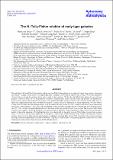The H I Tully-Fisher telation of early-type galaxies
Abstract
We study the H iK-band Tully-Fisher relation and the baryonic Tully-Fisher relation for a sample of 16 early-type galaxies, taken from the ATLAS3D sample, which all have very regular H i disks extending well beyond the optical body (≳ 5 Reff). We use the kinematics of these disks to estimate the circular velocity at large radii for these galaxies. We find that the Tully-Fisher relation for our early-type galaxies is offset by about 0.5-0.7 mag from the relation for spiral galaxies, in the sense that early-type galaxies are dimmer for a given circular velocity. The residuals with respect to the spiral Tully-Fisher relation correlate with estimates of the stellar mass-to-light ratio, suggesting that the offset between the relations is mainly driven by differences in stellar populations. We also observe a small offset between our Tully-Fisher relation with the relation derived for the ATLAS3D sample based on CO data representing the galaxies’ inner regions (≲1 Reff). This indicates that the circular velocities at large radii are systematically 10% lower than those near 0.5−1 Reff, in line with recent determinations of the shape of the mass profile of early-type galaxies. The baryonic Tully-Fisher relation of our sample is distinctly tighter than the standard one, in particular when using mass-to-light ratios based on dynamical models of the stellar kinematics. We find that the early-type galaxies fall on the spiral baryonic Tully-Fisher relation if one assumes M/LK = 0.54 M⊙/L⊙ for the stellar populations of the spirals, a value similar to that found by recent studies of the dynamics of spiral galaxies. Such a mass-to-light ratio for spiral galaxies would imply that their disks are 60-70% of maximal. Our analysis increases the range of galaxy morphologies for which the baryonic Tully-Fisher relations holds, strengthening previous claims that it is a more fundamental scaling relation than the classical Tully-Fisher relation.
Citation
den Heijer , M , Oosterloo , T A , Serra , P , Jozsa , G I G , Kerp , J , Morganti , R , Cappellari , M , Davis , T A , Duc , P-A , Emsellem , E , Krajnovic , D , McDermid , R M , Naab , T , Weijmans , A-M & de Zeeuw , P T 2015 , ' The H I Tully-Fisher telation of early-type galaxies ' , Astronomy & Astrophysics , vol. 581 , pp. A98 . https://doi.org/10.1051/0004-6361/201526879
Publication
Astronomy & Astrophysics
Status
Peer reviewed
ISSN
0004-6361Type
Journal article
Description
Milan den Heijer was supported for this research through a stipend from the International Max Planck Research School (IMPRS) for Astronomy and Astrophysics at the Universities of Bonn and Cologne. Jürgen Kerp and Milan den Heijer thank the Deutsche Forschungsgemeinschaft (DFG) for support on the grants KE 757/7-2 and KE 757/9-1. M.C. acknowledges support from a Royal Society University Research Fellowship. This work was supported by the rolling grants “Astrophysics at Oxford” PP/E001114/1 and ST/H002456/1 and visitors grants PPA/V/S/2002/00553, PP/E001564/1 and ST/H504862/1 from the UK Research Councils. T.A.D. acknowledges the support provided by an ESO fellowship. T.N. acknowledges support from the DFG Cluster of Excellence “Origin and Structure of the Universe”. A.W. acknowledges support of a Leverhulme Trust Early Career Fellowship. The research leading to these results has received funding from the European Community’s Seventh Framework Programme (/FP7/2007-2013/) under grant agreement No. 229517. The authors acknowledge financial support from ESO.Collections
Items in the St Andrews Research Repository are protected by copyright, with all rights reserved, unless otherwise indicated.

